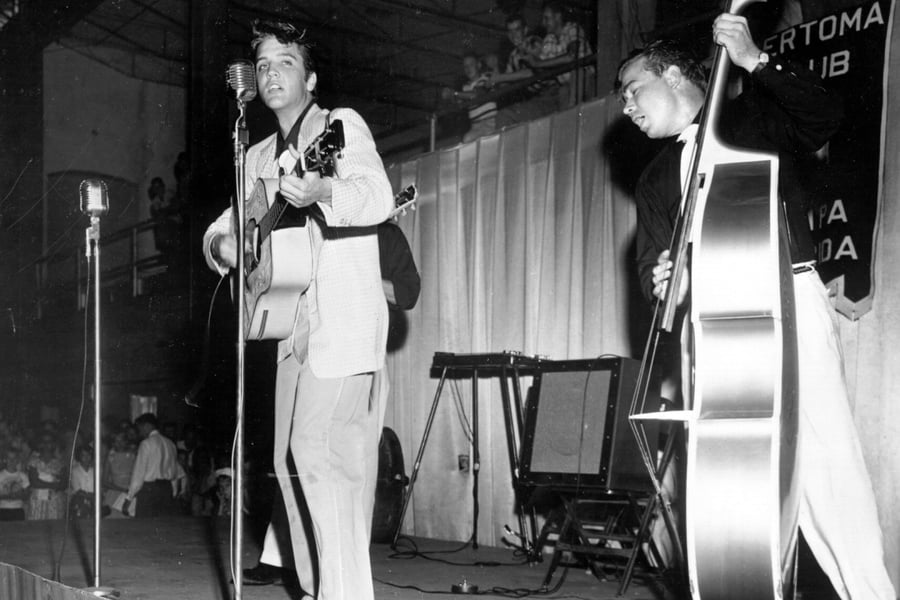To the causal listener, Paul Simon’s signature song, “Graceland”, seems like a straightforward nod to the restorative powers of a visit to Elvis Presley’s former home and museum, Graceland. But Simon later explained that the song’s hook—”I’m going to Graceland, Graceland / Memphis, Tennessee”— got stuck in his head before he’d ever been to the Memphis-based National Historic Landmark.
Simon told the Rock & Hall Of Fame that after fiddling with the song for a few months, the lines still hadn’t left him. “I said, ‘Gee, I can’t get it out of my head. I’d better go down to Graceland and see if there is something this song is telling me.’”
History tells us that Simon’s trip to Memphis affirmed his premonition—not only did the lyrics stay in place, but ‘Graceland’ became the title track on Simon’s most highly-regarded solo LP, released in 1986.
In a broader sense, there’s nothing unusual about Simon’s attraction to Elvis’ former mansion home. Elvis purchased the rural property in 1957 and lived there until he passed away in 1977. Graceland opened to the public in 1982 and remains one of the USA’s most popular tourist destinations—along with bagging a spot on Rolling Stone’s list of the 10 Great American Music Landmarks, USA Today readers voted Graceland the #1 Best Holiday Historic Home Tour in 2021.
Between his debut release in 1954 and his death 23 years later, Elvis released a lot of commercially successful and culturally impactful music spanning country, rock’n’roll, gospel and R&B. But Graceland’s capacity to lure in tourists more than 40 years after Elvis’ death is a testament to the Tupelo-born performer’s multi-faceted appeal.
For Australian music junkies and pop culture expeditionists, a visit to Graceland has been off limits for the past few years. But courtesy of Bendigo Art Gallery director Jessica Bridgfoot and curatorial manager Lauren Ellis, a significant chunk of the Graceland archive is coming to regional Victoria from March 19 – July 17, 2022.
Love Music?
Get your daily dose of everything happening in Australian/New Zealand music and globally.
 View this post on Instagram
View this post on Instagram
The Bendigo Art Gallery exhibition, “Elvis: Direct from Graceland”, contains artefacts from Elvis’ childhood in northern Mississippi in the late 1930s and evidence of the extent to which Elvis was wowed by the Black-influenced culture that prevailed in downtown Memphis in the early 1950s.
The exhibition follows Elvis’ uncanny rise to stardom in the mid 1950s and looks at how, by virtue of his enormous celebrity, Elvis not only left an imprint on popular music, but also influenced men’s style and grooming practices for years to come, giving rise to the archetypal image of a rock’n’roll star.
Elvis might’ve grown up in the 1930s and shot to fame in the 1950s, but his fashion instincts were out of step with most men of his era. Inspired in part by his on-screen heroes like Marlon Brando, Tony Curtis, and James Dean, Elvis did his own hair and make-up, wearing eyeliner and mascara beneath a thick head of pompadoured hair.
“Direct From Graceland” connects the dots between Elvis the heartthrob and Elvis the down-home mama’s boy. It shows how, with help from Memphis haberdasher, Bernard Lansky, Elvis started wearing immaculately tailored suits as far back as high school. The exhibition includes a job application Elvis lodged at the Tennessee Employment Office in 1953; an application that describes Elvis as a “rather flashily dressed” “playboy type”.
The exhibition underlines Elvis’ significant musical contributions. Elvis rarely wrote his own material and in the early days borrowed indiscriminately from the likes of Carl Perkins, Arthur Crudup, and Big Mama Thornton. But Elvis enjoyed unprecedented commercial success, landing 18 singles at the top of the US charts and selling out 1140 consecutive concerts between 1960 and 1977. At last count, Elvis has sold more than a billion record units worldwide.
The “Direct from Graceland” exhibition pays attention to Elvis’ status as an old-fashioned double-threat: he starred in 31 Hollywood films from the mid-’50s to the late-’60s without ever abandoning his recording career. The car from 1961’s Blue Hawaii—a bright red 1960 MG convertible—is one of the more extravagant items on display in Bendigo.
At the peak of his fame, in late 1950s, Elvis was drafted into the U.S. Army for 24 months of compulsory military service. Elvis feared the army stint might jeopardise his career, but along with his military uniforms, the exhibition includes a selection of Elvis’ famous white jumpsuits from the 1970s, revealing that Elvis’ post-military career was one of continued artistic and stylistic reinvention.
The bejewelled and tasseled white jumpsuits of Elvis’ Vegas years were created by his go-to designer, Bill Belew. Belew was also responsible for the two outfits Elvis wore during his televised ’68 Comeback Special. The most indelible image from the special is that of Elvis soaked in sweat, wearing a black leather suit.
View this post on Instagram
“Direct from Graceland” includes plenty of behind-the-scenes items from the Graceland archive, including baby clothes worn by Elvis and Priscilla Presley’s daughter, Lisa Marie, and the crayon box he took to school as an impoverished first grader. Elvis’ paisley-embroidered wedding tuxedo is there too, right next to Priscilla’s elegant white wedding dress.
The exhibition illuminates the various reinventions Elvis undertook over the course of his 42 year lifetime. It sheds light on how his humble beginnings gave way to a life of luxury and excess. But more than that, “Direct From Graceland” showcases the maverick glamour and mercurial personality that justifies Elvis’ reputation as the King of rock’n’roll.



































